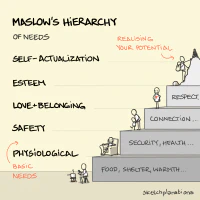I love getting inspired, and sometimes that inspiration comes from unexpected places. This advertisement from Fjordland about the hungry ballerina? Totally relatable!
The ad begins with the ballerina worrying that her mom might not make it home in time. Her thoughts quickly spiral to the worst-case scenario: not being chosen as the main ballerina. She imagines her “nemesis,” Tyril, becoming famous and stealing both the spotlight and Birgir, the boy she likes. Everything goes downhill from there. But then her mom walks in, unaware of all the drama, and gives her some food—instantly curing her “hanger.” By the end, the ballerina feels calm and content. Why is this so relatable? No matter how old we are, we all just want our basic needs met so we can feel calm and content—whether it’s in our personal or professional lives. And as leaders (or parents or human beings in general), we need to keep this in mind. Here’s are some of my reflections:
Maslow’s Hierarchy of Needs:

When the ballerina started spiraling because her basic needs weren’t met (like food, or in this case, being hangry), she couldn’t focus on anything else, let alone higher-level objectives. The same applies at work: as leaders, we need to make sure our team’s basic needs—like clear communication, recognition, or job security—are met before we can expect them to thrive and be creative. Without these fundamentals in place, it’s easy for us all to lose focus and get caught in a negative mindset.
Emotional Intelligence (EQ):
Have you ever been “hangry”? That feeling ties directly to emotional regulation, a key part of emotional intelligence. As leaders, we need to be aware of our own emotional states, as well as the emotional needs of others. Just as the ballerina’s mom stepped in to meet a basic need and restored balance, leaders can provide support, empathy, or encouragement when a team member is overwhelmed or stuck in a negative thought loop.
Self-awereness and Mindfulness:
The ballerina’s overthinking highlights the importance of self-awareness in leadership. Many leaders and individuals experience “catastrophizing” where small issues escalate into larger concerns in their mind. Introducing mindfulness practices into your routine, both as a leader and in your personal life, can help manage these spiraling thoughts. Simple practices such as breathwork, reflection and being in the moment tend to be good ways of self-regulating.
Servant Leadership:
The mom in the advertisement represents a form of servant leadership. She sees her daughter’s need (hunger) and fills it without expecting praise. Similarly, servant leaders focus on the well-being of their team members, ensuring their needs are met so that they can perform their best.
So to summarize, as humans—whether we’re parents, spouses, or leaders—simply attending to basic needs can profoundly shift both our own emotional state and the productivity of others.
Link to the Maslow’s Hierarchy Image by Jono Hey, Sketchplanations


